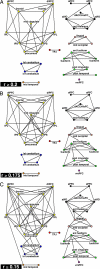Distinct brain networks for adaptive and stable task control in humans
- PMID: 17576922
- PMCID: PMC1904171
- DOI: 10.1073/pnas.0704320104
Distinct brain networks for adaptive and stable task control in humans
Abstract
Control regions in the brain are thought to provide signals that configure the brain's moment-to-moment information processing. Previously, we identified regions that carried signals related to task-control initiation, maintenance, and adjustment. Here we characterize the interactions of these regions by applying graph theory to resting state functional connectivity MRI data. In contrast to previous, more unitary models of control, this approach suggests the presence of two distinct task-control networks. A frontoparietal network included the dorsolateral prefrontal cortex and intraparietal sulcus. This network emphasized start-cue and error-related activity and may initiate and adapt control on a trial-by-trial basis. The second network included dorsal anterior cingulate/medial superior frontal cortex, anterior insula/frontal operculum, and anterior prefrontal cortex. Among other signals, these regions showed activity sustained across the entire task epoch, suggesting that this network may control goal-directed behavior through the stable maintenance of task sets. These two independent networks appear to operate on different time scales and affect downstream processing via dissociable mechanisms.
Conflict of interest statement
The authors declare no conflict of interest.
Figures




References
-
- Posner MI, Petersen SE. Annu Rev Neurosci. 1990;13:25–42. - PubMed
-
- Chawla D, Rees G, Friston KJ. Nat Neurosci. 1999;2:671–676. - PubMed
-
- Visscher KM, Miezin FM, Kelly JE, Buckner RL, Donaldson DI, McAvoy MP, Bhalodia VM, Petersen SE. Neuroimage. 2003;19:1694–1708. - PubMed
-
- Braver TS, Barch DM. Trends Cogn Sci. 2006;10:529–532. - PubMed
Publication types
MeSH terms
Grants and funding
LinkOut - more resources
Full Text Sources
Other Literature Sources

